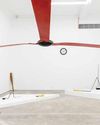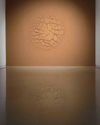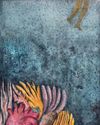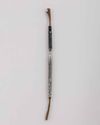
The sunny summer morning in Kassel has a sullen air.
I recognise the gloom as being from the recent scandal that has rocked the city. There isn't a swarm of visitors either, and the last few days have had a number of performances cancelled. There appears to be a lack of celebration; it is, what one might call, a disheartened atmosphere.
A few days after the exhibition's inauguration on the 18th of June, a work by the Indonesian collective Taring Padi was heavily criticised for being antisemitic. The work had created media headlines in Germany it is an eight-meter-high and twelve-meter-wide painting called People's Justice from 2002 that depicts Suharto's rule from 1967 to 1998 and the power of the Indonesian people's resistance to the dictatorship. My first reaction was to visit the Bauhaus-styled Hallenbad Ost which houses the works of Taring Padi's practice of the last 22 years. However, I found no replica of People's Justice at the venue.
There is, however, a large swimming pool filled with cement to present other works by the collective. People's Justice framed moments of violence and captured acts of protest and retaliation. Installed in a central location in Kassel, the painting showed - warmongering monsters, marching soldiers, grieving people, in a sweeping depiction of strife and conflict. The figures in the painting that incited people to level accusations of anti-Semitism against Ruangrupa, the Indonesian collective that curated this edition of the documenta, included those of a cigar-chomping, fang-baring, bloody-eyed Jew with a SS hat and a pig-headed soldier with 'Mossad' written on his helmet.
Denne historien er fra August 2022-utgaven av Art India.
Start din 7-dagers gratis prøveperiode på Magzter GOLD for å få tilgang til tusenvis av utvalgte premiumhistorier og 9000+ magasiner og aviser.
Allerede abonnent ? Logg på
Denne historien er fra August 2022-utgaven av Art India.
Start din 7-dagers gratis prøveperiode på Magzter GOLD for å få tilgang til tusenvis av utvalgte premiumhistorier og 9000+ magasiner og aviser.
Allerede abonnent? Logg på

Parts, Wholes And The Spaces In Between
Sonal Sundararajan introduces Samira Rathod's free-spirited and rebellious explorations in the world of architecture, furniture and design.

"The Fine Art of Going to the Pictures."
Dr. Banerjee in Dr. Kulkarni's Nursing Home at Chemould Prescott Road brings together 26 paintings featuring a series of dramatic scenes from Hindi and Bengali films. In conversation with Abhay Sardesai, artist Atul Dodiya talks about childhood trips to movie halls, painted figures gripped by tension, and the closeness and remoteness of cinematic images.

"To Finally Have Something of Your Own to Mine."
Dayanita Singh is the recipient of the coveted 2022 Hasselblad Award. Keeping the photograph at the centre, she speaks to Shreevatsa Nevatia about books, book objects, photo novels, exhibitions and museums.

OF DIVINE LOSS
Shaurya Kumar explores the relationship between the subject and object of devotion, finds Aranya.

THE PAST AND ITS SHADOWS
Neha Mitra visits two shows and three artists in Mumbai.

FORCE OF NATURE
Alwar Balasubramaniam dwells on absences and ephemeralities in his new work, states Meera Menezes.

SHAPES OF WATER
Devika Sundar's works delineate the murky, malleable boundaries between the human body and the organic world, says Joshua Muyiwa.

INTIMATIONS OF INTIMACY
Sunil Gupta shares his journey with Gautami Reddy.

THE FRACTURED PROSPECT
Nocturnal landscapes as ruins in the making? Adwait Singh looks at Biraaj Dodiya's scenes of loss.

TEETERING BEYOND OUR GRASP
Meera Menezes traces Mahesh Baliga's journey from Moodabidri to London.